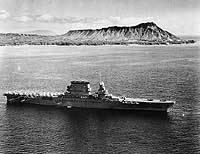
USS Lexington, a 33,000-ton aircraft carrier, was converted while under construction from the battle cruiser of the same name. Built at Quincy, Massachusetts, and commissioned in December 1927, Lexington was one of the U.S. Navy's first two aircraft carriers that were large and fast enough to be capable of serious fleet operations. During the late 1920s, through the 1930s and into the early 1940s, she took an active part in the development of carrier techniques, fleet doctrine and in the operational training of a generation of Naval Aviators.
Lexington was in the Pacific when Japan attacked Pearl Harbor and took part in the U.S. Navy's first wartime operation, the abortive attempt in December 1941 to relieve Wake Island. In February and March 1942, she raided Japanese positions in the southwestern Pacific, then returned to Pearl Harbor for a brief overhaul and removal of her eight-inch guns.
In early May, Lexington returned to the South Pacific in time to join USS Yorktown (CV-5) in successfully countering the Japanese offensive in the Coral Sea. On 7 and 8 May 1942 her planes helped sink the small Japanese aircraft carrier Shoho and participated in attacks on the large carriers Shokaku and Zuikaku. In turn, however, she was the target of Japanese carrier planes and received two torpedo and three bomb hits. Though initial damage control efforts appeared to be successful, she was racked by gasoline explosions in the early afternoon of 8 May. When the fires raged out of control, Lexington was abandoned by her crew and scuttled, the first U.S. aircraft carrier to be lost in World War II.
This page features selected views of USS Lexington (CV-2).
For extensive pictoral coverage of Lexington during the Battle of Coral Sea, including views of her underway, Japanese air attacks on her, her damage, abandonment and destruction, as well as photographs taken from her planes as they attacked the Japanese aircraft carrier Shoho, see: Battle of the Coral Sea, 7-8 May 1942.
For views related to the battle cruiser design from which Lexington was converted, see: Lexington Class Battle Cruisers.
| If you want higher resolution reproductions than the digital images presented here, see: "How to Obtain Photographic Reproductions." |
Click on the small photograph to prompt a larger view of the same image.
|
Photo #: NH 64500 USS Lexington (CV-2) Off Panama City, Panama, 25 March 1928, during her shakedown period. Collection of Franklin Moran, 1967. U.S. Naval Historical Center Photograph. Online Image: 75KB; 740 x 605 pixels |
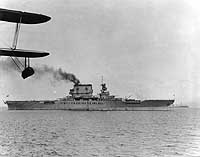 |
|
Photo #: NH 82117 USS Lexington (CV-2) Launching Martin T4M-1 torpedo planes, circa 1929. Collection of LCdr. Abraham DeSomer, donated by Myles DeSomer, 1975. U.S. Naval Historical Center Photograph. Online Image: 124KB; 740 x 610 pixels |
 |
|
Photo #: 80-G-416531 USS Lexington (CV-2) Off Honolulu, Oahu, Hawaii, with Diamond Head in the background, 2 February 1933. Official U.S. Navy Photograph, now in the collections of the National Archives. Online Image: 153KB; 740 x 595 pixels Reproductions of this image may also be available through the National Archives photographic reproduction system. |
 |
|
Photo #: NH 67420 USS Lexington (CV-2) Off Long Beach, California, 17 September 1936, with crewmembers spelling out "NAVY" on her flight deck. Courtesy of Commander Robert L. Ghormley, Jr., 1969. U.S. Naval Historical Center Photograph. Online Image: 92KB; 740 x 615 pixels |
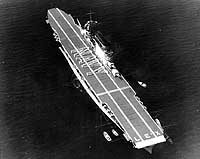 |
|
Photo #: NH 75714 USS Lexington (CV-2) Steams through an aircraft-deployed smoke screen, 26 February 1929, shortly after that year's "Fleet Problem" exercises. Courtesy of the Naval Historical Foundation, Washington, D.C. Collection of Admiral William V. Pratt. U.S. Naval Historical Center Photograph. Online Image: 93KB; 740 x 605 pixels |
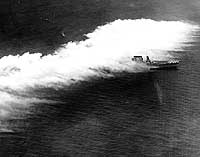 |
|
Photo #: 80-G-416362 USS Lexington (CV-2) Leaving San Diego, California, 14 October 1941. Planes parked on her flight deck include F2A-1 fighters (parked forward), SBD scout-bombers (amidships) and TBD-1 torpedo planes (aft). Note the false bow wave painted on her hull, forward, and badly chalked condition of the hull's camouflage paint. Official U.S. Navy Photograph, now in the collections of the National Archives. Online Image: 111KB; 740 x 610 pixels Reproductions of this image may also be available through the National Archives photographic reproduction system. |
 |
|
Photo #: NH 76560 USS Lexington (CV-2) Underway during the Battle of Coral Sea, 8 May 1942. This view appears to have been taken in the early afternoon, after planes had been recovered and initial damage control measures effected, but before the start of the fires that led to the ship's loss. This is the last known photograph of Lexington in operational condition. Taken from USS Portland (CA-33). Courtesy of the Naval Historical Foundation, Washington, D.C., 1972. Collection of Captain Benjamin Perlman. U.S. Naval Historical Center Photograph. Online Image: 56KB; 740 x 310 pixels |
 |
|
Photo #: NH 51382 USS Lexington (CV-2) Burning and sinking after her crew abandoned ship during the Battle of Coral Sea, 8 May 1942. Note planes parked aft, where fires have not yet reached. U.S. Naval Historical Center Photograph. Online Image: 84KB; 740 x 610 pixels |
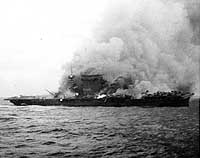 |
|
Photo #: NH 51380 USS Lexington (CV-2) Curtiss F6C fighters (lower right) and Martin T3M torpedo planes on the carrier's flight deck, as she arrives off San Diego, California, on her maiden cruise, 4 April 1928. Note lowered elevator. U.S. Naval Historical Center Photograph. Online Image: 113KB; 740 x 570 pixels |
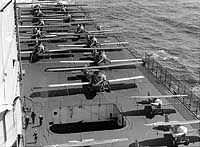 |
|
Photo #: NH 51384 USS Lexington (CV-2) Ship's crew and personnel of her aircraft squadrons posed on the flight deck, circa the 1930s. View looks forward from atop her smokestack. U.S. Naval Historical Center Photograph. Online Image: 183KB; 740 x 605 pixels |
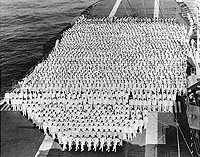 |
|
Photo #: 80-CF-21126-7 USS Lexington (CV-2) On the building ways at the Fore River Shipyard, Quincy, Massachusetts, shortly before her launching, circa late September or early October 1925. Taken by a photographer from Naval Air Station Lakehurst, New Jersey. Photograph from Department of the Navy collections in the U.S. National Archives. Online Image: 138KB; 740 x 605 pixels Reproductions of this image may also be available through the National Archives photographic reproduction system. |
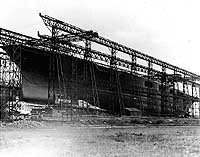 |
For extensive pictoral coverage of Lexington during the Battle of Coral Sea, including views of her underway, Japanese air attacks on her, her damage, abandonment and destruction, as well as photographs taken from her planes as they attacked the Japanese aircraft carrier Shoho, see: Battle of the Coral Sea, 7-8 May 1942.
| If you want higher resolution reproductions than the digital images presented here, see: "How to Obtain Photographic Reproductions." |
Links added 26 July 2000